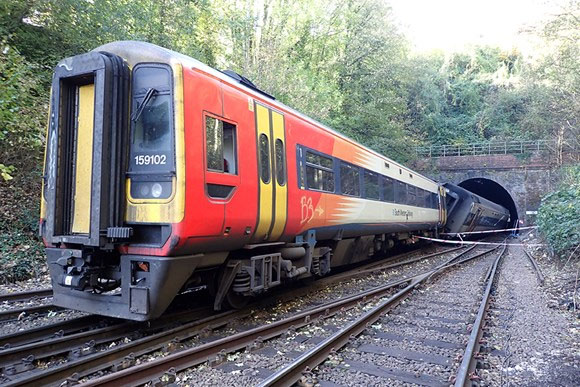At the time of Salisbury rail crash last Autumn, in which one train appears to have skidded into another, work to clean the rails of leaf debris had been delayed because of weekend engineering works, it has emerged.
The Rail Accident Investigation Branch (RAIB) has published its interim report into the incident in October, which led to one train driver being seriously injured and 13 passengers taken to hospital.

Image courtesy of RAIB
The RAIB had already revealed that the incident occurred when a South Western Railway (SWR) service from London Waterloo to Honiton (pictured) collided with the side of a Great Western Railway service from Portsmouth to Bristol, having passed a signal at danger.
In its latest report, it noted that Network Rail has arrangements for managing the risk of low adhesion during Autumn – mainly from the widely derided but potentially dangerous issue of ‘leaves on the line’ –with each National Rail route required to implement seasonal management arrangements and to review and re-issue these at least annually.
The 2021 arrangements for the Wessex route where the crash happened included railhead treatment trains (RHTT) – multi-purpose vehicles that can deliver high-pressure water jetting and may also apply a sand-based adhesion modifier gel, which introduces a friction improver. into the wheel/rail interface.
The report notes that on the day of the crash, Sunday 31 October, the RHTT that was due to treat Salisbury Tunnel Junction on the down mainline at 17:03 had not yet passed through the area because it had been rescheduled to around 23:00 because of planned engineering work between.
This ‘meant that there would have been an interval of 36 hours between the RHTT runs over the weekend’.
The crash occurred at around 18:43 hrs.
The RAIB said its survey of the down mainline on the approach to the accident site found evidence of railhead contamination at twelve sample locations over a distance of around two miles.
The contamination consisted of a black deposit of leaf material which had been crushed under the wheels of passing trains ‘and which is often associated with low adhesion conditions’.
Noting that it was likely that the rails were wet at the time of the incident, the RAIB said a combination of its own survey and analysis of the deceleration of the SWR train suggested very low levels of adhesion.
The RAIB said its continuing investigation would look at a number of issues, including:
- ‘the actions taken on the day of the accident to manage the risk of low adhesion given the time of year and prevailing weather conditions
- SWR’s policies and processes relating to operating trains in conditions of low wheel/rail adhesion
- Network Rail’s policies and processes relating to low wheel/rail adhesion ‘and how it managed the risk of low adhesion in the Salisbury area’.
Register now for full access
Register just once to get unrestricted, real-time coverage of the issues and challenges facing UK transport and highways engineers.
Full website content includes the latest news, exclusive commentary from leading industry figures and detailed topical analysis of the highways, transportation, environment and place-shaping sectors.
Use the link below to register your details for full, free access.
Already a registered? Login